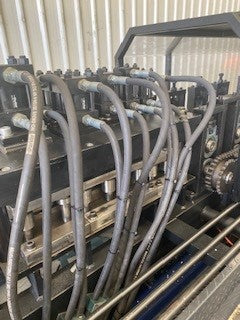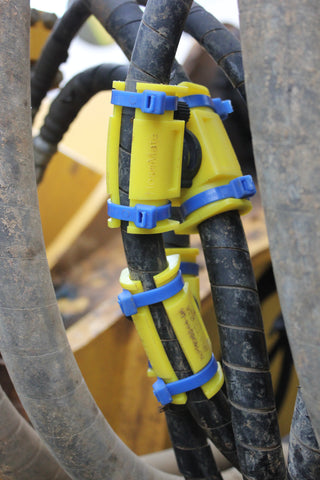Common mistakes to avoid when setting up hydraulic hoses
Employee injuries, machine downtime, and blowouts all have the potential to occur if you incorrectly set up a hydraulic hose assembly.
This blog will delve into the common mistakes made when routing hydraulic hoses. We will take a look at one example of a poor hydraulic hose set up and pull apart all the mistakes in it that have the potential to lead to catastrophic hose failure.
Read on to discover how NOT to set up a hydraulic hose and learn why HoseMateTM should be a staple in your hydraulic hose installation toolkit.
The picture below demonstrates an all-too-common hydraulic hose assembly set up on earthmoving equipment.

Cable ties
The first issue evidenced in this picture is the use of cable ties to keep the hoses together. The use of cable ties is one of the most common sights we see on hydraulic hose assemblies. Although cable ties present themselves as a cost-effective short-term fix, they present many WHS risks:
- Unlike HoseMateTM tension straps, cable ties are not heat stabilised or tested – meaning they are prone to snapping or degrading under extreme heat conditions
- The sharp edges presented by cable ties also have the potential to cause injuries to employees – such as cuts and scraps
As demonstrated by our picture, using cable ties to keep two, or more, hydraulic hoses together does not allow for the vibration and pulsing of hydraulic hoses when fluid moves through them. Multiple hydraulic hoses held together by cable ties are exposed to higher risks of external abrasion as the hoses are now forced to rub against each other, causing more damage.

Pictured is another example of poor hydraulic hose routing using cable ties.
Spiral fixings
Secondly, we can see that spiral fixings have been threaded over the hoses in an attempt to protect the outer layer of the hose from external abrasion. These fixings can be made different types of materials. We have spotted the use of plastic, rubber and metal fixings across different hose assemblies.

These fixings are often not designed to be used for this purpose and therefore suffer from wear and tear as a result of tough conditions.
The need for spiral fixings is eliminated with HoseMateTM. HoseMateTM separates hydraulic hoses to ensure they don’t rub against each other – reducing the risk of external abrasion. As the hoses are not rubbing against each other, spiral fixings are not longer needed.
Rope
Our final mistake issued by this picture is positioning the hoses with rope tied to equipment. Here, the rope is used to create a bend in the hoses, potentially to allow for the minimum bend radius of the hydraulic hose. However, using ropes or straps to position hydraulic hoses creates a messy workplace full of WHS risks, such as trip hazards. Rope also has the potential to fray, snap or tear under tension.

Say goodbye to complicated set ups – HoseMateTM is the easy to install affordable solutions.
All these mistakes can be avoided with HoseMateTM. Think twice about what you consider to be a simple fix at the time, as it may be a costly mistake in the future. Cable ties, spiral fixings, and rope are no longer required when setting up hydraulic hoses.

All you need is HoseMateTM. Read more on our simple to route hydraulic hoses correctly with HoseMateTM.
